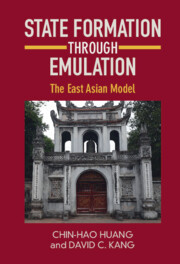Book contents
- State Formation through Emulation
- State Formation through Emulation
- Copyright page
- Epigraph
- Contents
- Preface
- 1 Introduction
- 2 Theories of State Formation and Diffusion
- 3 Phase I and Onwards
- 4 The Absence of Bellicist Pressures in State Formation, 400–800 CE
- 5 Phase II
- 6 Korea and Japan over the Centuries
- 7 Vietnam Emerges
- 8 Epistemic Communities and Regional Connections
- 9 Who Doesn’t Emulate?
- 10 Conclusion
- Appendix Major Events in Sinicization, 300–1100 CE
- Bibliography
- Index
8 - Epistemic Communities and Regional Connections
Published online by Cambridge University Press: 21 July 2022
- State Formation through Emulation
- State Formation through Emulation
- Copyright page
- Epigraph
- Contents
- Preface
- 1 Introduction
- 2 Theories of State Formation and Diffusion
- 3 Phase I and Onwards
- 4 The Absence of Bellicist Pressures in State Formation, 400–800 CE
- 5 Phase II
- 6 Korea and Japan over the Centuries
- 7 Vietnam Emerges
- 8 Epistemic Communities and Regional Connections
- 9 Who Doesn’t Emulate?
- 10 Conclusion
- Appendix Major Events in Sinicization, 300–1100 CE
- Bibliography
- Index
Summary
There was an extensive epistemic community in historical East Asia that was central to the creation and dissemination of regional civilization that flowed mainly from China outwards, from core to periphery. This epistemic community was composed of Buddhist monks and Confucian scholars. They studied at Buddhist temples and Confucian academies, wrote in a common Chinese language using common styles, and made up the bulk of government officials in each country. These scholar-officials were also the ones who staffed diplomatic missions to other countries. This chapter will discuss in detail the flows of monks and literati between the various countries, and trace the influence of this transnational scholarly and religious community on the evolution of societies – as well as state formation – throughout the region.
- Type
- Chapter
- Information
- State Formation through EmulationThe East Asian Model, pp. 155 - 171Publisher: Cambridge University PressPrint publication year: 2022

